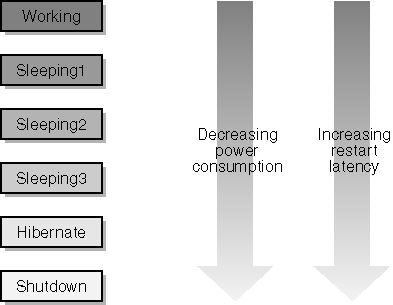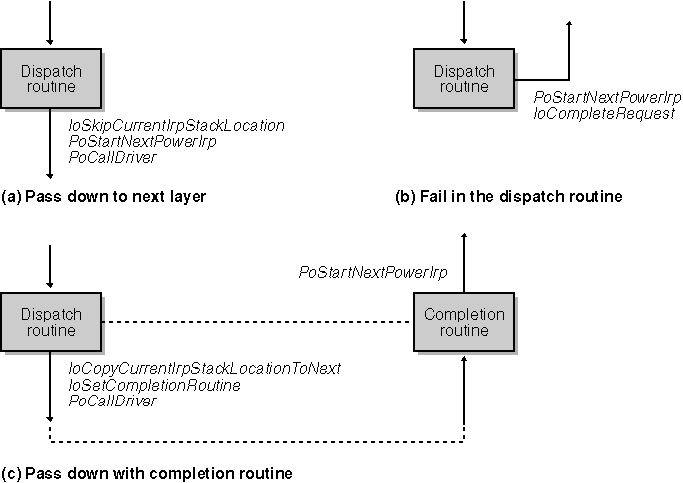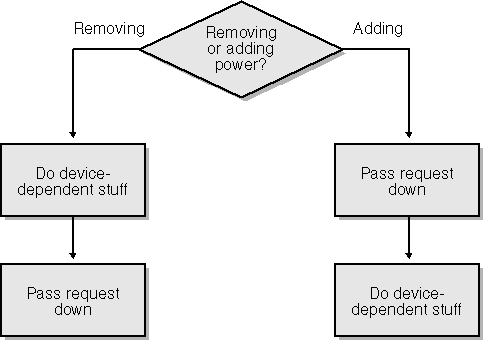The WDM Power Model
The WDM Power Model
In Windows XP and Windows 98/Me, the operating system takes over most of the job of managing power. This makes sense because only the operating system really knows what s going on, of course. A system BIOS charged with power management, for example, can t tell the difference between an application s use of the screen and a screen saver s. But the operating system can tell the difference and thus can determine whether it s OK to turn off the display.
As the global power policy owner for the computer, the operating system supports user interface elements that give the end user ultimate control over power decisions. These elements include the control panel, commands in the Start menu, and APIs for controlling device wake-up features. The Power Manager component of the kernel implements the operating system s power policies by sending I/O request packets (IRPs) to devices. WDM drivers have the primarily passive role of responding to these IRPs, although you ll probably find this passivity to incorporate a lot of active motion when I show you how much code is involved.
The Roles of WDM Drivers
One of the drivers for a device acts as the power policy owner for the device. Since the function driver most often fills this role, I ll continue discussing power management as though that were invariably the case. Just bear in mind that your device might have unique requirements that mandate giving the responsibilities of policy owner to a filter driver or to the bus driver instead.
The function driver receives IRPs (system IRPs) from the Power Manager that pertain to changes in the overall power state of the system. Acting as policy owner for the device, it translates these instructions into device terms and originates new IRPs (device IRPs). When responding to the device IRPs, the function driver worries about the details that pertain to the device. Devices might carry onboard context information that you don t want to lose during a period of low power. Keyboard drivers, for example, might hold the state of locking keys (such as Caps Lock, Num Lock, and Scroll Lock), LEDs, and so on. The function driver is responsible for saving and restoring that context. Some devices have a wake-up feature that allows them to wake up a sleeping system when external events occur; the function driver works together with the end user to make sure that the wake-up feature is available when needed. Many function drivers manage queues of substantive IRPs that is, IRPs that read or write data to the device, and they need to stall or release those queues as power wanes and waxes.
The bus driver at the bottom of the device stack is responsible for controlling the flow of current to your device and for performing the electronic steps necessary to arm or disarm your device s wake-up feature.
A filter driver normally acts as a simple conduit for power requests, passing them down to lower-level drivers by using the special protocol I ll describe a bit further on.
Device Power and System Power States
The Windows Driver Model uses the same terms to describe power states as does the Advanced Configuration and Power Interface (ACPI) specification. (See http://www.acpi.info.) Devices can assume the four states illustrated in Figure 8-1. In the D0 state, the device is fully functional. In the D3 state, the device is using no (or minimal) power and is therefore not functioning (or is functioning at a very low level). The intermediate D1 and D2 states denote two different somnolent states for the device. As a device moves from D0 to D3, it consumes less and less power. In addition, it remembers less and less context information about its current state. Consequently, the latency period needed for the device s transition back to D0 increases.

Figure 8-1. ACPI device power states.
Microsoft has formulated class-specific requirements for different types of devices. I found these requirements on line at http://www.microsoft.com/hwdev/resources/specs/PMref/. The specifications mandate, for example, that every device support at least the D0 and D3 states. Input devices (keyboards, mice, and so on) should also support the D1 state. Modem devices, moreover, should additionally support D2. These differences in specifications for device classes stem from likely usage scenarios and industry practice.
The operating system doesn t deal directly with the power states of devices that s exclusively the province of device drivers. Rather, the system controls power by using a set of system power states that are analogous to the ACPI device states. See Figure 8-2. The Working state is the full-power, fully functional state of the computer. Programs are able to execute only when the system is in the Working state.

Figure 8-2. System power states.
The other system power states correspond to reduced power configurations in which no instructions execute. The Shutdown state is the power-off state. (Discussing the Shutdown state seems like discussing an unanswerable question such as, What s inside a black hole? Like the event horizon surrounding a black hole, though, the transition to Shutdown is something you ll need to know about as your device spirals in.) The Hibernate state is a variant of Shutdown in which the entire state of the computer is recorded on disk so that a live session can be restarted when power comes back. The three sleeping states between Hibernate and Working encompass gradations in power consumption.
Power State Transitions
The system initializes in the Working state. This almost goes without saying because the computer is, by definition, in the Working state whenever it s executing instructions. Most devices start out in the D0 state, although the policy owner for the device might put it into a lower power state when it s not actually in use. After the system is up and running, then, it reaches a steady state in which the system power level is Working and devices are in various states depending on activity and capability.
End user actions and external events cause subsequent transitions between power states. A common transition scenario arises when the user uses the Stand By command in the Turn Off Computer dialog box to put the machine into standby. In response, the Power Manager first asks each driver whether the prospective loss of power will be OK by sending an IRP_MJ_POWER request with the minor function code IRP_MN_QUERY_POWER. If all drivers acquiesce, the Power Manager sends a second power IRP with the minor function code IRP_MN_SET_POWER. Drivers put their devices into lower power states in response to this second IRP. If any driver vetoes the query, the Power Manager still sends an IRP_MN_SET_POWER request, but it usually specifies the current power level instead of the one originally proposed.
The system doesn t always send IRP_MN_QUERY_POWER requests, by the way. Some events (such as the end user unplugging the computer or the battery expiring) must be accepted without demur, and the operating system won t issue a query when they occur. But when a query is issued, and when a driver accepts the proposed state change by passing the request along, the driver undertakes that it won t start any operation that might interfere with the expected set-power request. A tape driver, for example, will make sure that it s not currently retensioning a tape the interruption of which might break the tape before allowing a query for a low-power state to succeed. In addition, the driver will reject any subsequent retension command until (and unless) a countervailing set-power request arrives to signal abandonment of the state change.
Handling IRP_MJ_POWER Requests
The Power Manager communicates with drivers by means of an IRP_MJ_POWER I/O request packet. Four minor function codes are currently possible. See Table 8-1.
| Minor Function Code | Description |
| IRP_MN_QUERY_POWER | Determines whether prospective change in power state can safely occur |
| IRP_MN_SET_POWER | Instructs driver to change power state |
| IRP_MN_WAIT_WAKE | Instructs bus driver to arm wake-up feature; provides way for function driver to know when wake-up signal occurs |
| IRP_MN_POWER_SEQUENCE | Provides optimization for context saving and restoring |
The Power substructure in the IO_STACK_LOCATION s Parameters union has four parameters that describe the request, of which only two will be of interest to most WDM drivers. See Table 8-2.
| Field Name | Description |
| SystemContext | A context value used internally by the Power Manager |
| Type | DevicePowerState or SystemPowerState (values of POWER_STATE_TYPE enumeration) |
| State | Power state either a DEVICE_POWER_STATE enumeration value or a SYSTEM_POWER_STATE enumeration value |
| ShutdownType | A code indicating the reason for a transition to PowerSystem Shutdown |
All drivers both filter drivers and the function driver generally pass every power request down the stack to the driver underneath them. The only exceptions are an IRP_MN_QUERY_POWER request that the driver wants to cause to fail and an IRP that arrives while the device is being deleted.
Special rules govern how you pass power requests down to lower-level drivers. Refer to Figure 8-3 for an overview of the process in the three possible variations you might use. First, before releasing control of a power IRP, you must call PoStartNextPowerIrp. You do so even if you are completing the IRP with an error status. The reason for this call is that the Power Manager maintains its own queue of power requests and must be told when it will be OK to dequeue and send the next request to your device. In addition to calling Po StartNextPowerIrp, you must call the special routine PoCallDriver (instead of IoCallDriver) to send the request to the next driver.
NOTE
Not only does the Power Manager maintain a queue of power IRPs for each device, but it maintains two such queues. One queue is for system power IRPs (that is, IRP_MN_SET_POWER requests that specify a system power state). The other queue is for device power IRPs (that is, IRP_MN_SET_POWER requests that specify a device power state). One IRP of each kind can be simultaneously active. Your driver might also be handling a Plug and Play (PnP) request and any number of substantive IRPs at the same time too, by the way.

Figure 8-3. Handling IRP_MJ_POWER requests.
The following function illustrates the mechanical aspects of passing a power request down the stack:
NTSTATUS DefaultPowerHandler(IN PDEVICE_OBJECT fdo, IN PIRP Irp) { 
PoStartNextPowerIrp(Irp); 
IoSkipCurrentIrpStackLocation(Irp); 
PDEVICE_EXTENSION pdx = (PDEVICE_EXTENSION) fdo->DeviceExtension; return PoCallDriver(pdx->LowerDeviceObject, Irp); } -
PoStartNextPowerIrp tells the Power Manager that it can dequeue and send the next power IRP. You must make this call for every power IRP you receive at a time when you own the IRP. In other words, the call must occur either in your dispatch routine before you send the request to PoCallDriver or in a completion routine.
-
We use IoSkipCurrentIrpStackLocation to retard the IRP s stack pointer by one position in anticipation that PoCallDriver will immediately advance it. This is the same technique I ve already discussed for passing a request down and ignoring what happens to it afterwards.
-
You use PoCallDriver to forward power requests. Microsoft implemented this function to forestall the minimal, but nonetheless measurable, impact on performance that might result from adding conditional logic to IoCallDriver to handle power management.
The function driver takes the two steps of passing the IRP down and performing its device-specific action in a neatly nested order, as shown in Figure 8-4: When removing power that is, when changing to a lower power state it performs the device-dependent step first and then passes the request down. When adding power when changing to a higher power state it passes the request down and performs the device-dependent step in a completion routine. This neat nesting of operations guarantees that the pathway leading to the hardware has power while the driver manipulates the hardware.

Figure 8-4. Handling system power requests.
Power IRPs come to you in the context of a system thread that you must not block. There are several reasons why you can t block the thread. If your device has the INRUSH characteristic, or if you ve cleared the DO_POWER_PAGABLE flag in your device object, the Power Manager will send you IRPs at DISPATCH_LEVEL. You remember, of course, that you can t block a thread while executing at DISPATCH_LEVEL. Even if you ve set DO_POWER_PAGABLE, however, so that you get power IRPs at PASSIVE_LEVEL, you can cause a deadlock by requesting a device power IRP while servicing a system IRP and then blocking: the Power Manager might not send you the device IRP until your system IRP dispatch routine returns, so you ll wait forever.
The function driver normally needs to perform several steps that require time to finish as part of handling some power requests. The DDK points out that you can delay the completion of power IRPs by periods that the end user won t find perceptible under the circumstances, but being able to delay doesn t mean being able to block. The requirement that you can t block while these operations finish means lavish use of completion routines to make the steps asynchronous.
Implicit in the notion that IRP_MN_QUERY_POWER poses a question for you to answer yes or no is the fact that you can cause an IRP to fail with that minor function code. Having the IRP fail is how you say no. You don t have any such freedom with IRP_MN_SET_POWER requests, however: you must carry out the instructions they convey.
EAN: 2147483647
Pages: 119